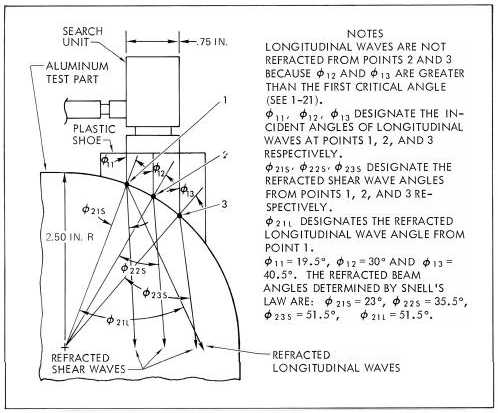T.O. 33B-1-1
5-39
NOTE
Unwanted surface waves can be detected by noting additional unexpected signals on
the waveform display. If these signals can be damped and traced to their source
using an oil-wetted finger as explained in 5.3.3.3, unwanted surface waves are
being generated.
j. When designing shoes for curved surfaces, the sound beam path in the shoe and the test part must be
considered in order to assure coverage of the area of interest within the test part. Generally the sound
beam path in the shoe can be considered to be a straight projection of the face of the search unit; in
almost all cases the sound travel in the shoes will be in the near field, characterized by no beam spread
(see paragraph 5.1.6.2.2 and Figure 5-12). The beam path in the part can be obtained by using Snell's
Law to determine the refracted angle at various points across the sound beam where it enters the test
part surface (see paragraph 5.1.5.1 and Figure 5-43).
Figure 5-43. Example of Determining the Sound Beam Path in a Test Part with a Curved Surface.
k. With certain inspection setups, particularly when using shoes to generate straight beams in parts with
curved surfaces, multiple reflections from the shoe-to-test part interface can interfere with the
inspection. To avoid this, the shoe shall be made thick enough to avoid interference with the intended
inspection application. Consider the inspection setup shown in Figure 5-44. It is important only that
the inspector be able to recognize and identify indications on the waveform display. Reflections caused
by the shoe are easily recognized simply by raising the shoe off the surface of the material. If the
indications remain on the screen, the plastic shoe is the cause. Slotting the shoe as shown in Figure 5-
41 may reduce or eliminate such interference signals. It is not necessary for the operator to calculate
the sound paths to and from various reflectors. However, it is important the operator know how to
recognize nonrelevant indications from the reflectors and minimize their cause.

